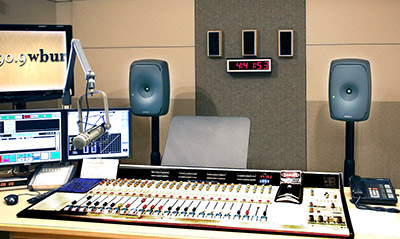Boston’s WBUR NPR radio station has won hundreds of awards for reporting, features and news series, documentaries, investigative reports and digital innovation – including numerous National Edward R Murrow Awards. Part of its mission is excellence in audio, as evidenced by the recent acquisition of a pair of Genelec 8351A SAM Smart Active Monitors.
 Installed in the station’s Studio 3 – and joining the Genelec 1031A monitors in WBUR’s three other studios – the new monitors have quickly proved their worth on a broad mix of talk and music programmes.
Installed in the station’s Studio 3 – and joining the Genelec 1031A monitors in WBUR’s three other studios – the new monitors have quickly proved their worth on a broad mix of talk and music programmes.
‘What we have now is a full-range speaker in the same amount of space as a typical close-field monitor,’ says WBUR Chief Engineer Michael LeClair, who is responsible for all the technical aspects of transmission and audio production facilities. ‘In a radio studio, you don’t have a ton of space, but nowwith the 8351A, we can hear the way you would in a larger studio with bigger monitors. We’re hearing low frequencies like we’ve never heard them before. Certainly for music, but also even in the voices of the announcers
‘It had been hard to tell exactly what the real low end was like on typical close-field monitors, so you tended to pull back on it a bit,’ he elaborates. ‘But the first time we turned the 8351As on, the image was exact, immediately. It gives you the confidence you want in a mix.’
LeClair explains that he’s avoided using subwoofers, because they can lead to phase problems. Now, with the full-spectrum three-way 8351A, the entire range of audio is present and always fully phase-coherent. He is also happy with Genelec’s proprietary technology that’s integrated into the 8351A, specifically designed to optimise the monitor for its environment. Computer-controlled Smart Active Monitoring (SAM) technology fully aligns a monitoring system with regards to level, timing and room response equalisation – all done automatically – as well as being configurable by the end user. Like all active monitors in the Genelec SAM range, the 8351A is capable of automatically adapting to acoustical environments to offer an indispensable tool for sound professionals in broadcasting, postproduction, music studios and remote recording environments.
‘I was stunned when I heard music through them for the first time, after we had done our first pass using the DSP,’ he says. ‘And the mixes translate well to air. We know we’re getting it right. That’s why we’re planning on budgeting for a second pair for next year. They really are that good.’
More: www.genelec.com














